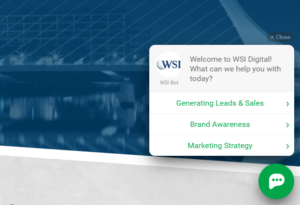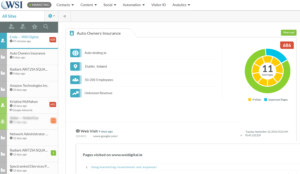
Your Website Is a Two-Way Channel
Today’s digital marketing landscape is packed with interaction, user-generated content, dynamic search results and more. It’s no wonder that the competition for leads grows ever more fierce. How is it possible to cut through all the noise and provide real impact with your visitors?
You’ll need to put yourself in the mind of your website visitor.
What would they be thinking?
Most likely, they will be searching for something that offers value and, if they don’t find it quickly, they’ll move on.
Considering your visitor’s viewpoint more carefully is the first step to creating a two-way channel of communication.
It seems simple, but it’s surprising how often marketers can miss the mark. If your website isn’t equipped to offer real value to the visitors, your potential leads are likely to leave. According to one study, 84% of 25 to 34 year-old’s have clicked out of a website because of an irrelevant or intrusive ad1. Consumers know when companies aren’t thinking about their needs.
So to generate more leads, you’ll need a dynamic website. A dynamic website that interacts with, and adapts to, visitors based on their individual actions and needs. It’s a website that works for your organization 24/7, by engaging with visitors and helping them along the buying journey.
One such way is by making it easier for customers to start a conversation with you and Chatbots are a great way to do this. You can direct visitors to other areas of your site and even take them down your sales funnel at any time.
To see a live example of how chatbots work, why not check out our Chatbot in the bottom corner of this blog – Come say hello!

You can also consider marketing automation as another way to open up that two-way channel of communication. It doesn’t have to be complicated though. Here are some features that can make an impact on your visitor experience.
Visitor Identification
Certainly, your site is a way for visitors to learn about you, but it should also be a way for you to gain key insights about your visitors to help identify leads and move them through a sales funnel.
Did you know that 98% of web visitors remain anonymous because they don’t fill out forms?2 It seems impossible to capture that 98% without form fill-outs, but it’s actually easy if you use anonymous site visitor identification.
Visitor identification, typically included in a marketing automation platform, uses reverse IP lookup to identify your site visitors. It provides you with contact info, including names, emails, phone numbers, and social media links – effectively doubling or tripling the number of leads that can be harvested from your existing web traffic.
This information can be used in an outreach campaign as you now know that these organisations are interested in your offering.

You can also use this information to personalize your site’s messaging based on the visitor’s organization, title, social media content, etc. Visitor identification allows you to guide your messaging, design, etc… to be more effective and relevant. Now that is some next-level stuff!
Dynamic Content
Once you’ve implemented visitor tracking on your website, your site identifies and remembers its visitors and you can add dynamic content personalized for each visitor. We use this on some of our automated “Request A Callback” pages where the ‘thank you’ page addresses the visitor by name and references the scheduled call.

Dynamic content allows you to engage visitors by creating a landing page, or a series of landing pages, where the content changes based on the visit number, or even each visitor’s past behavior. Dynamic content can also be used in automated emails.
For example, a first visit may offer an introductory video, a second visit may offer an educational white paper, and a third visit may offer a discount code. This series of landing pages effectively nurture a lead until they’re ready to convert, and the dynamic content doesn’t stop after the click.
Email Automation
Did you know that email marketing drives more conversions than any other marketing channel, including search and social?3 And email automation takes traditional email marketing one step further.
Email automation, like dynamic content, allows marketers to send relevant, personalized emails based on a lead’s specific interests, website engagement, and personal traits. And the emails can be triggered at exactly the right time based on site activity.

If you segment your contacts with marketing automation, you can automatically send emails to these groups based on any specific attribute, including age, location, industry, professional role, visit number and more.
In essence, marketing automation, working in tandem with automated email, offers these essential advantages:
- Discover a lead’s interests, simply based on web page clicks, similarly to the Visitor ID methods from above.
- Communicate with those leads 1-to-1 based on their interests.
- Automatically notify a salesperson when a lead is ready to convert.
Don’t Get Left Behind
It’s simply not enough for your website to look pretty and sit passively on the sidelines. To generate leads, it requires strategy, listening, and the right tech.
Two-way websites that leverage marketing automation have become an exciting new tool for marketers to create personal, two-way conversations that can dramatically boost lead generation.
Consider this: 63% of companies that are outgrowing their competitors use marketing automation.4 This two-way communication approach to web design can help marketers drive more leads, convert leads to sales and optimize marketing spend.
So it’s no wonder that this technology helps companies grow past their competition.
References:
1 mashable.com 2011
2 polymash.com 2014
3 campaignmonitor.com 2014
4 lenskold.com 2014

Stay Connected